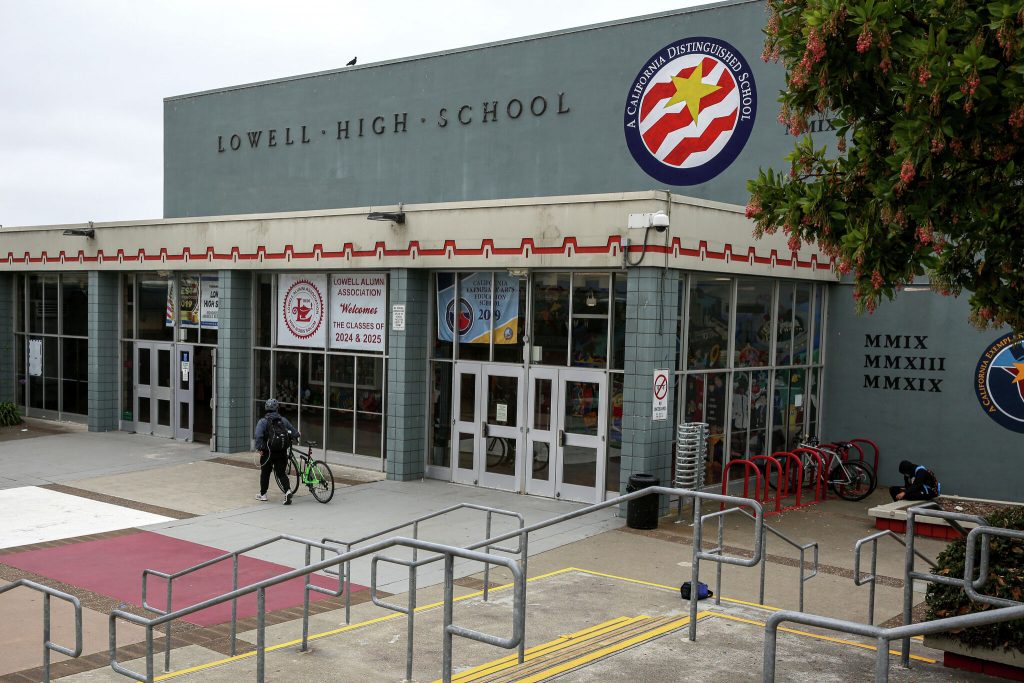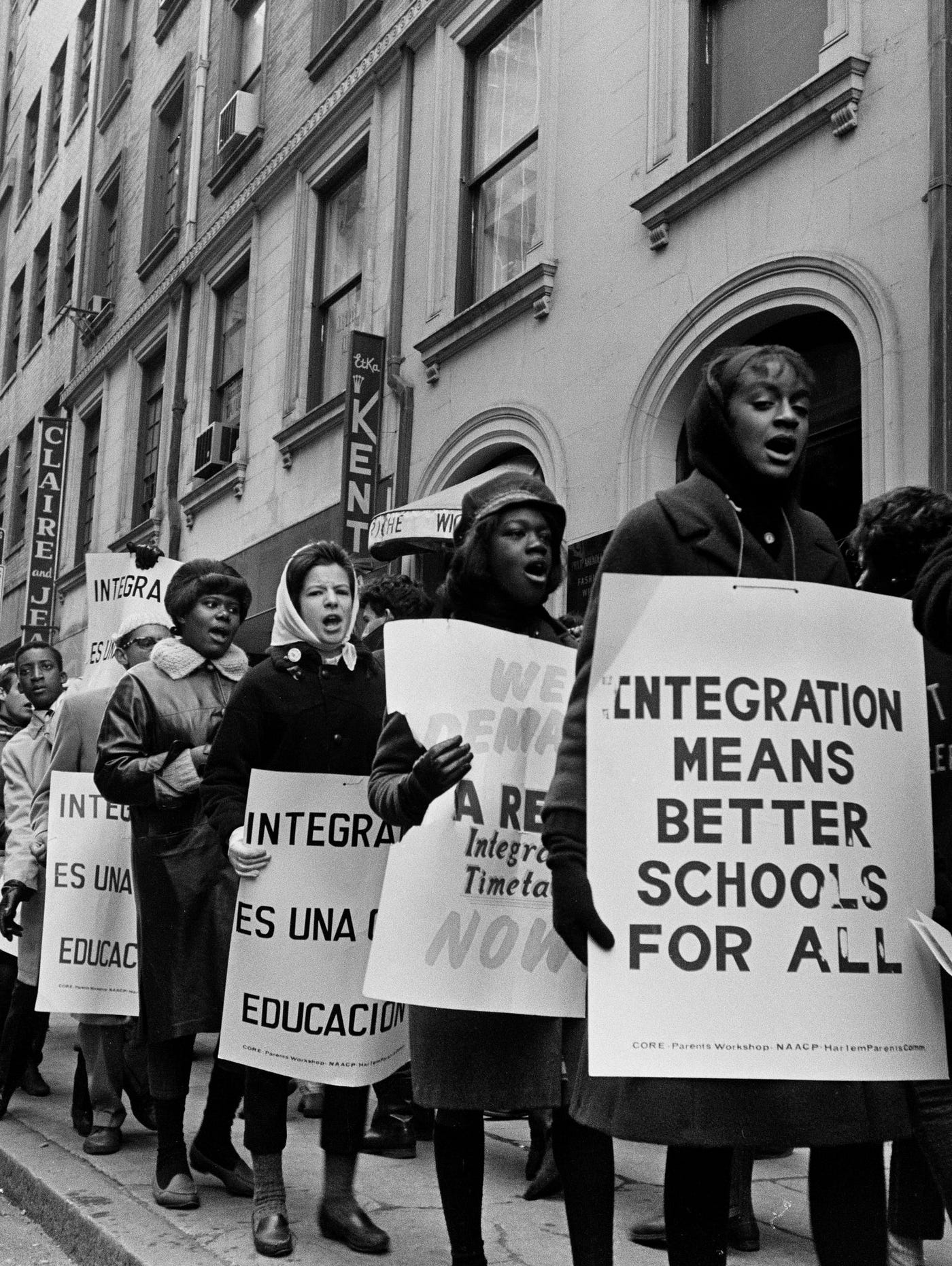The city of San Francisco, seated at the center of innovation and wealth, has a long history of trying to reverse the effects of neighborhood segregation within the San Francisco Unified School District (SFUSD). In the 1970s, their first desegregation attempt was enacted through the Horseshoe Plan and Operation Integrate, dividing SF into zones to which students were assigned based on race. This plan included a busing program, in which students spent half their elementary school years at a school close to where they lived, spending the other half “busing” to a different campus in their zone. Although this plan was initially effective, it was contested, primarily by white and Asian families living on the western side of the city, who pushed for accessibility to neighborhood schools. Black families who were residents of Bayview and Hunters Point, two of the most historically segregated and disadvantaged neighborhoods in San Francisco, expressed discontent as well. They claimed it was a one-way system, one in which Black students had to leave the neighborhood more often than other racial groups had to bus into theirs. In 1978 a new plan was introduced and enacted with the hope for increased racial diversity district-wide.

Educational Redesign, which lasted until 1983, required every school to enroll students from at least four different racial groups, with no school being allowed to have one race exceeding 45% of their enrollment. There was support from white and Asian families on the west side of the city because busing became a requirement for students in neighborhoods that weren’t already “racially integrated;” this meant students of color on the east side of the city were increasingly more likely to be assigned to a school outside of their neighborhood. The NAACP sued SFUSD over this policy given the burden of busing was falling primarily on Black students and disproportionately affecting the very students SFUSD aimed to help. From 1983 to 2000, SFUSD enacted the Student Assignment System, using racial standards from educational redesign and calling for an increase in resources for schools in Bayview and Hunters Point. The aim was to address these neighborhoods’ historical disadvantages and attract families from other neighborhoods. This plan experienced extreme success in its early stages, with the district containing only one racially identifiable school in 1992, meaning the rest had more than four races represented with no race taking up more than 45% of enrollment. However, this success diminished in 1999 when the Chinese Democratic Club sued SFUSD for using race as a factor in school admissions and won; the courts disallowed the use of race in students’ future school assignment plans.
With the usage of race being disallowed by the courts, SFUSD turned to using “race-neutral factors” in their Diverse Index Lottery, which they believed would lead to racially diverse schools. These factors included socioeconomic status, test scores, and English proficiency, all correlated with the race of students in SFUSD. This plan was largely ineffective, with 25% of SFUSD schools containing over 60% of a single race by 2008, and the plan was replaced in 2010. At this same time, the Williams Act (2008), following the Williams Case brought against California state agencies by SFUSD students, required students to have adequate resources and that these resources be distributed equally district-wide.
SFUSD’s current school assignment system has lasted since 2011, containing a choice system in which families can apply to any school in the district. They rank their choices, and if more students apply than spots available, “tiebreakers” are used to decide where students are placed. The results of the current system are unfavorable to the goal of diversifying SFUSD, with schools more segregated now than they were 30 years ago. In 2019, 60% of SFUSD elementary schools enrolled more than 45% of one racial group, and 25% enrolled more than 60% of a single group. The total population of SFUSD is racially and ethnically diverse, and no single group contains over 30% of total elementary school enrollment. Families of students from historically redlined and disadvantaged areas wish their neighborhood schools provided a better education so they didn’t feel forced to send their children far away for school. However, these families acknowledge certain tiebreakers in the assignment system are their only way to access a better education for their kids. Many parents have pushed for district quality assessments to improve the quality of all district schools, instead of SFUSD’s persistent focus on the assignment system.
Lowell High School is the academic crown and jewel of SFUSD, yet it simultaneously highlights many of the district’s primary issues regarding a lack of diversity and inequality between schools. With the arrival of the COVID-19 pandemic, SFUSD made the change from a merit-based system of acceptance into Lowell, which was based on middle-school GPA and standard test scores, to the lottery system utilized by other high schools in the district. In the 2021-22 school year, prior to this change, Lowell had less than 2% of their enrollment identifying as Black and less than 12% who identified as Latinx. Meanwhile, the district contained 8% of students identifying as Black and 32% Latinx students. In response to this stark lack of representation of underserved minority groups, SFUSD attempted to abandon Lowell’s long-standing tradition of selective acceptance. This was denied for the incoming freshman class in 2023 when Lowell returned to merit-based acceptance.
Is SFUSD’s continued attempts at altering their school acceptance system making a significant impact on the diversity of schools, and the ability of historically underserved students to succeed at “better” high schools in the district? When Lowell made the switch to the lottery system for the 2021-2022 admission year, teachers reported handing out an increased number of D and F letter grades to the freshman class. The percentage difference of freshmen receiving failing grades rose from 7.9% in the fall of 2020 to 24.4% in the fall of 2021. Although this rise is likely due to a variety of factors, including the pandemic, there is a likely correlation between the switch to a lottery-based system and the rise of failing grades. This points to a much larger story behind this concerning data; one of inadequate resources and under-preparation in schools containing primarily Black and Latinx students. Lowell High School’s switch from merit-based acceptance to lottery, then back to a merit-based system, has taught us that the district has serious issues regarding equal opportunity in elementary and middle schools. These issues can’t be solved by just changing the student assignment system. The district should consider a multifaceted approach, starting with the improvement of elementary schools in historically redlined and underperforming neighborhoods.

Students coming from neighborhoods such as Hunters Point and Bayview who were thrown into the competitive Lowell environment after years at schools producing below-average test scores struggled to adjust. There are various paths SFUSD could explore to work towards uplifting these schools, so in future attempts to diversify the district’s more desirable schools such as Lowell, Lincoln, and George Washington, students will be far more prepared for success. Community schools are an initiative that has gained significant support from organizations such as the California Teachers Association. Such schools reflect the needs of the specific they reside in, giving those involved in the educational process (teachers, students, parents, community members, etc) a voice in the decision-making process. It also gives teachers more resources to assist students in overcoming barriers outside of the classroom, ones that could have a significant impact on their educational performance. The implementation of the community-based school has already been tried at a few San Francisco schools, with positive outcomes in a short amount of time. In Martin Luther King Middle School, located on the outskirts of Hunters Point, suspension rates between the 2014-2015 and 2019-2020 school years dropped by 85%, which is just one indicator of the success of a community-based education.
There is also significant evidence that securing funding outside of what is provided by the district and state is a marker of a more successful school. There is a prevalent opportunity gap between public schools in wealthier neighborhoods and schools in underserved communities. This gap widens through the large differences in Parent Teacher Association (PTA) funding that district and state funding cannot compete with. In San Francisco, this difference can be observed in schools such as Grattan Elementary, located in the western Haight Ashbury neighborhood, and Junipero Serra Elementary School, located in the eastern Bernal Heights neighborhood. Where Grattan’s PTA raises almost $1000 dollars annually per pupil, Junipero Serra’s PTA raises about $25 per pupil. The promotion of funding policies that promote alignment and partnership efforts with organizations outside the district have shown beneficial results for underserved schools with a lack of PTA funding. Schools have the opportunity to apply for grants and to build and maintain relations with funders, however, many schools are unable to take full advantage of partnerships due to their lack of knowledge and resources. Assisting school principals and community leaders with cultivating connections to outside partners could provide a significant increase in funding to schools that don’t have equitable PTA support.
In 2018, SFUSD implemented “PITCH” schools—or Professional Capacity, Instructional Guidance, Transformative Mindsets, Collaborative Culture, and High-Quality Staff. 20 schools, 10 being historically underserved and 10 with a high opportunity gap within their school, were selected due to their large performance gap within their Black student population. PITCH schools created plans and provided evidence that they were implementing these strategies for improvement. After the 2017-2018 school year, the reading Lexile increase of Black students in PITCH schools was 16 points higher compared to Black students who were in non-PITCH schools. According to an SFUSD report in 2019, PITCH schools such as Presidio Middle School and John Muir Elementary had significant success with the implementation of PITCH practices. In two years at John Muir Elementary, there was over a 20% increase in the number of students meeting or exceeding English Language Arts (ELA) and math standards. The largest increase for ELA was Black students, and these same students showed a high increase in math scores as well. Presidio Middle School has made significant improvements in both ELA and math, closing the ELA performance gap by double digits. Being located in Hayes Valley and the Presidio, both relatively wealthy neighborhoods, John Muir Elementary, and Presidio Middle School are among those selected for PITCH due to the high achievement gap within their school. Having shown significant strides in narrowing the achievement gap within schools such as John Muir and Presidio, SFUSD should consider how implementing this program in similar schools across the district could improve the equity at those institutions.
Looking toward the future of diversity, opportunity, and achievement in SFUSD has to be approached through multiple pathways. There is no simple fix to systemic racial inequities that have lasted for decades. SFUSD’s primary focus on its admission policies has proved to be complicated and confusing for students of all backgrounds and hasn’t seen much recent success in diversifying the district or preparing underserved students for challenging academics. There have been significant successes in attempts to uplift elementary and middle schools in historically redlined and disadvantaged areas of the city, with markers of student improvement such as higher test scores and decreases in the number of suspensions. Targeting equitable educational opportunity and performance at a young age can prepare students of all races and backgrounds for success in academically challenging schools like Lowell High School, and would assist the district in their efforts to diversify and close the opportunity gap.
Feature Image: Medium





Comments are closed.